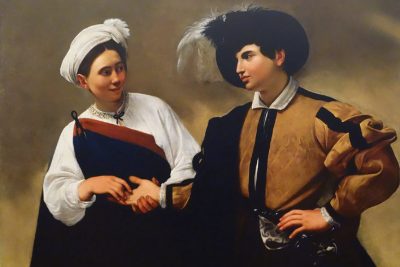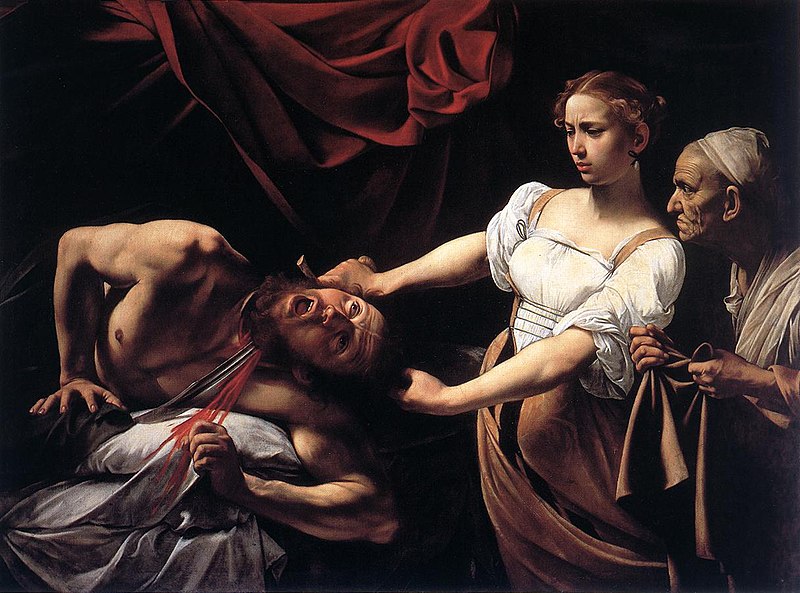Trials of the Flesh: Extraordinary Painter with New Eyes, Caravaggio in Milan

The ambitiously conceived exhibition ‘Dentro Caravaggio’ (Inside Caravaggio) wants us to see this extraordinary painter with new eyes. Currently on display at the Palazzo Reale in Milan, eighteen masterpieces are accompanied by never-before-seen reflectographs and x-radiographs. These artistic diagnoses offer viewers a glimpse into Caravaggio’s creative process – to see how he worked, to observe his method. To be sure, the journey that this exhibition takes us on is revelatory and transformative.
Caravaggio is ultimately a painter of exposure, revealing the human experience as one of constitutive vulnerability. Michaelangelo Merisi was born in 1571 in the town of Caravaggio, not far from Milan, where he spent much of the first twenty years of his life, before making his way to Rome. With the arrival of the plague, Caravaggio’s family was not spared: by the time he was eight, the boy had lost his uncle, grandfather, and father. There can be little doubt that early exposure to extreme terror, physical anguish and death informed his vision as a painter who specializes in scenes of humanity in extremes.
No hope no fear. This was the motto of Caravaggio and his comrades. When we look at his life—the constant run-ins with the law, his sword and dagger wielding escapades in Rome, his irascibility and propensity to self-sabotage; his readiness to quarrel, attack and even to kill—we see a man who seems to be perpetually drawn to the edge, who only knows how to live at the extreme verge of existence. And in fact, the truth of his art is just that: it expresses our ineluctable fate – our existence is always and ever on the brink of being and non-being.

Caravaggio Judith Beheading Holofernes (Source: Wikimedia Commons)
Nowhere is this clearer than in Judith Beheading Holofernes (1599-1600), where we see the Assyrian General precisely at the moment when he is no longer alive, and not yet dead. The show opens with this breathtaking masterpiece: a work of such immense power that one is left speechless before it, as if a witness to the ravishingly beautiful Judith and her deliberate and studied decapitation of the powerful man she has just seduced. In the painting, the heroine’s lips are parted slightly, a rendering that is true to the Book of Judith which tells us that the pious widow prayed Give me strength this day, O Lord God of Israel as she severed the head of her enemy. As the late art historian E. H. Gombrich rightly observed,
“Caravaggio must have read the Bible again and again, and pondered its words.”
Not mentioned in the text are Judith’s erect nipples, visible beneath her semi-translucent blouse. This subtly underscores the eroticism of an unusually violent act of unexpected intimacy – where the Assyrian is literally being penetrated by his own sword, undone by the very thing which represents his power, his manhood. The mighty commander is brought low by a determined young woman, while her wizened old maid looks on ready to gather the head “in her food bag” once her mistress has succeeded in detaching it.
Caravaggio painted St. John the Baptist numerous times, and two of these are in the exhibit. The more extraordinary one is St. John the Baptist in the Wilderness (ca.1603), now owned by the Nelson-Atkin’s Museum in Kansas City, Missouri. This is a John who speaks to us loudly, even as he sits silent and brooding.

St. John the Baptist in the wilderness, c. 1604, oil on canvas; The Nelson-Atkins Museum of Art, Kansas City, Missouri | Photo: Jamison Miller (Source: The Nelson-Atkins Museum of Art)
At first sight, the young man can easily be viewed as a rather moody adolescent – but the sullenness is not mere juvenile petulance. This is a deeply religious rendering of John as he meditates on his ultimate fate – which will be to suffer execution on the orders of King Herod; he knows about the abuse of power, and the corruption of conscience it breeds. With the intense chiaroscuro, the picture is lit as though a flash of lightening has, for an instant, illuminated John in a woodland setting. The severity and intensity of this saint, with his crimson drapery, animal furs, and simple reed cross reminds us that this is a preacher of repentance: a Nazarite who understood the inadequacy and folly of mankind, along with the reckless and foolish ways of those who wield power.
In the Madonna of Loreto (1605), two kneeling peasants pray before the Virgin and Child. Caravaggio characteristically emphasizes the naked legs and exposed dirty feet of the male pilgrim, as well as the torn soiled cap of the old woman. While it is undoubtedly true that pilgrims to Loreto entered the shrine with bare feet and tattered clothing to display their humility, the artist’s insistence on their poverty reveals his affinity for the severe pauperist strain of the Catholic counter-reformation. Caravaggio’s Christianity is emphatically a Christianity of the poor. Andrew Graham-Dixon rightly calls the painting “a tour de force of naked religious populism … blatant in its appeal to the masses.”
Caravaggio’s work is a prolonged meditation on the vulnerability which marks our condition regardless of how powerful or brave we might be, regardless of our skill with a blade. In fact, Caravaggio was, by all accounts, a quite proficient swordsman; so much so that in 1606 he killed a man in a prearranged duel, prompting his flight from Rome.
By 1607 Caravaggio found refuge in Naples, where he would transform painting literally overnight. Among the greatest treasures to be included in the show is the monumental Flagellation of Christ (1607), a painting of such harrowing brutality that it is almost unbearable. At the same time, it is the consummation of Caravaggio’s art, one of his most perfectly realized works, encapsulating his vision of humanity in all its terrible beauty and fragility. Initially greeted by the Neapolitans with “stunned admiration, bordering on bewilderment,” the Flagellation lays bare for all to see the true meaning of fleshly existence, and the radical vulnerability it implies.
On the one hand, we are witnessing a man being tortured, confronted with its awful and twisted form of intimacy. We see the classically conceived Christ as he is literally beginning to collapse from exhaustion, while his tormentors kick, snarl and yank his hair to get him back in place. There hardly appears to be any note of transcendence here – we seem to be alone with nothing but darkness lying beyond a scene of torment. At the same time, Christ’s body has within it a kind of luminescence: in the very flesh that is being savaged there is a divinity. Caravaggio finds the transcendence here, in this world – God is made manifest in the flesh.
Although his art soared, and commissions poured in, Caravaggio’s troubles did not end: he would acquire new and dangerous enemies among the Knights of Malta, who for a time welcomed the painter and were even prepared to make him one of their own. Caravaggio’s portrait of the dignified and stern Maltese Knight, Fra. Antonio Martelli (1608) is included in the exhibition – it is one of the finest of the seventeenth century, and would have a powerful influence on Rembrandt, among others.

Portrait of a Knight of Malta, 1607-1608, oil on canvas, Pitti Palace, Florence (Source: The Uffizi Gallery)
In just over a year, the painter would fall out with the brotherhood and eventually suffer grievously for a perceived insult to one of its members. In 1610, as he left a tavern in Naples, Caravaggio was ambushed and his face badly mutilated. A struggle for his life ensued, and shortly after his recovery he was finally permitted to return to Rome. However, ill fate and exhaustion caught up with the artist and he died enroute.
With the Martyrdom of St. Ursula (1610) we have what is perhaps Caravaggio’s final painting. Ursula stands, gazing down, her fingers placed on either side of the arrow that has just been fired at pointblank range into her chest by the King of the Huns. It is a terrible scene of very matter-of-fact, almost mechanical, killing. Ursula is caught, like many of Caravaggio’s other subjects, between life and death. She hovers at the edge of the abyss, and the insinuation – in the positioning of her hands and her slightly protruding belly – is that she is about to give birth, highlighting the interpenetration of living and dying. The picture contains the last portrait we have of the painter, whose upturned head peers blindly into the impenetrable darkness, mouth agape as though overcome by the desperation and inscrutability of our human lot.
This exhibition brings out a Caravaggio that we cannot afford to overlook. “…to be afraid of ugliness seemed to Caravaggio a contemptible weakness,” as Gombrich observed, “what he wanted was truth.” Caravaggio insists on a Christianity of the poor and underprivileged, on a realism that is unabashed and uncompromising – and at a time when we seem to be drowning in the lies and the corruption emanating from powerful elites, the painter offers us a sorely needed antidote.
Sam Ben-Meir is a professor of philosophy and world religions at Mercy College in New York City.

